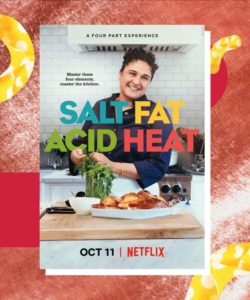My dad imparted to me that the secret in cooking is the ability to sauté the core spices: garlic, onion, tomatoes. But to my awakening, a new Netflix series expanded my knowledge, paying attention to these four essential elements of cooking: “SALT FAT ACID HEAT”. The show, based on Samin Nosrat’s book, encourages its viewers that anybody is capable of cooking too once they know how to master these four.

As Samin Nostrat shares her extraordinary experiences about food, she highlights these 4 secrets: salt, fat, acid and heat, into making the perfect dish through her documentary series. Four information-packed episodes that talked about its sources, tactile effect and cultural connection. She emphasises that these four essentials can make or break your dish.

1. SALT.
 The episode about salt revealed that Japan has about 4,000 kinds of salt. While they manufacture salt quite differently from the rest, salt brings out the flavour of anything that it seasons. Salt with bigger flakes tend to dissolve slower than those that are almost powdery to touch. No matter how big or small, no matter your preference, the secret is to know what works for you in seasoning your food.
The episode about salt revealed that Japan has about 4,000 kinds of salt. While they manufacture salt quite differently from the rest, salt brings out the flavour of anything that it seasons. Salt with bigger flakes tend to dissolve slower than those that are almost powdery to touch. No matter how big or small, no matter your preference, the secret is to know what works for you in seasoning your food.
Meat, salad, and believe it or not, even ice cream. Samin tried it in Japan and you can tell from her facial reaction that it punched her palate with a flavour that was beyond her expectation and satisfying all at the same time.
And that’s what actually makes the show so good to watch. Her reactions are natural plus the conversations with the grandmothers are not scripted. She presents her show in the most comfortable way in terms of clothes, eating the tacos and very little conscious effort is given in keeping her beautiful profile favoured by the camera.
The whole world agrees that every dish has to have a certain amount of salt. May it be in other forms besides the usual that we use on the containers. It can be through soy sauce, olives or cheese.
I particularly like Samin’s wrist method in salting meat in one of the four episodes. She explains the importance of doing so right when you come home and you put away your groceries. Since salt preserves the meat with flavour she encourages you do so before you let it stay in the freezer. With a plan to slow-cook spare ribs at that time, this prepares her meat even better.
You can learn that and a lot more such as filtering salt from the sea water using seaweed, how microbes and particles from the air brings the best in soy sauce and how cheese becomes rich through time.
Different kinds of salt is used depending on how you want it to react to your viands. Kosher salt somehow has a distinct shape that Samin takes into consideration when finishing up a salad. She said, it’s not just for seasoning purposes that she had put it there. But also for the rough cracky feel when you toss the leaves into your mouth.
On the other hand, she admits that she doesn’t favour table salt as this always give food a tangy metallic taste. I agree. But for faster seasoning, then you use it.
My personal favourite is the Himalayan Pink Salt. It’s salty enough and makes my eggs have a crunch. As the flavour dissolves in the mouth, the egg also melts and blends into it. Yum!
2. ACID.

It’s magical to know that in Yucatán, Mexico, they have a market that is solely dedicated to citrus. Lemons, pineapples, mandarins, oranges, name any citrus fruit and they have it. They even have ‘sweet’ lemons, ‘sour’ oranges (shouldn’t those descriptive be interchanged to other? nah! it’s really what they call it!) and gooseberries. See the contrast?
Let me take what acid does best from that statement.
Acid, gives edgy touch to your dish. It neutralizes and balances anything salty. On the other hand, salt, tames the acid. When you get these two ingredients working hand in hand with each other, the result is magic.
I’ll give you an example of a Filipino dish that had this worked out so well.
Sinigang.
It’s anything that is cooked in tamarind soup base. Salmon head, pork ribs, beef, prawns… sometimes, with taro (that thickens the soup) added or miso (that gives it a twang of a soup consistency).
While Mexico uses a lot of citrus fruits to make their food zesty, here in Hong Kong, they use lemon most of the time. Lime gets too expensive but it is also sought after for many dishes that involves salsa, sisig, kinds of salads and if one wants to revive time when they went to Thailand.
But for me, the most powerful citrus would be calamansi. Filipinos marinade a lot of meat with it, makes their sauces unforgettable because of it and once squeezed on our papaya, ooohhhh!!!! It’s going to make your toes curl up because of the blastful combination of sweet and sour popping in your mouth at the same time.
Inspired by this citrus effect, I have cooked my version of Lemon Butter Codfish to sell to our loyal customers in Gogobaon. I was quite surprised as how the people have given positive comments about it because it was my first time to cook it. Thanks to Samin Nosrat’s idealism of putting these 4 elements together, I have given satisfaction to our customers.

3. FAT
So many people are disgusted of this when it is infused in our daily dishes. The thing is, it’s not only that marbl”y” thing around your steak. It actually comes in many forms such as oil, butter, cream and mayonnaise. Yes, the dressing that you put in your salad sometimes. But you can’t just remove it from the dishes we’re so familiar with just because you’re on a diet?! It’s because of one obvious reason: it makes your food delicious.
Don’t deny it, without that little chewy fat side on top of your steak, you wouldn’t be able to enjoy it for what its worth. Because, the fat makes it sumptuous and juicy. Bread without butter is boring. And frying without oil is just impossible.
Samin Nosrat actually gives it equal importance as salt and acid because of the unique flavour it gives our food. It gives it texture, it gives it consistency and it helps to amplify the rest of the flavours a dish can have. Simply put, if your food doesn’t have enough fat in it, it may taste as bare as paper. If you have too much of it, it can make you gag in no time. It’s your body’s natural response on anything too much anyway.
So, if you don’t know how to choose the correct fat to put into your cooking, you may be pretty much doomed. Master how to harness its magic along with that of the strong two elements in the beginning and you can never go wrong.

4. HEAT
Once the first three had come together and blended perfectly, it’s time to bring out the best in them through heat. Sometimes, people forget the added transformation of food via heat. From being raw (meat separate from the salt, separate from the acid and separate from the oil), it cooks it to perfection (blended flavours come to form one dish that is hard to distinctly separate each ingredient from one another). Needless to say, magic happens.
Heat, being a powerful element, combined with water, can soften the toughest meat and can harden the most fragile egg. In all the processes, heat becomes a substantial part because once used wrongly, it may destroy your dish unequivocally.
Samin introduces a technique to master the usage of this element. She encourages everybody to make all 5 of our senses working. Sight (look at the brown color), Hearing (the sizzling can tell you whether it’s getting overcooked or not), Smell (to gauge if it’s burning), Taste (bitter means burnt) and Touch (food sometimes need cooling before it gets dressed).
Heat is responsible for creating rich aromas that involve our neurotic senses. It delights us in certain ways remembering how our mothers got busy in the kitchen. It creates steam that could bring something flabby to being firm. The crackles of french fries gets you excited and the golden brown it gives our dishes are all results of heat.
Another strategy that Samin gave in dealing with heat is to know your ingredients, know your spices and understand how to make them work side by side. For example, in Italy, they want their pasta not soggy but al dente. When using the oven, proper thawing of the turkey and pre-heating the oven is important to cook your turkey all the way to the inside. Searing is different from frying. And baking is different from steaming. In the Philippines, vegetables are cooked last to keep it fresh and colourful.
All in all, what Samin shares is very simple.
The most important thought that I learned from Samin Nosrat’s Netflix series is that, choose to be kind always. Do everything with love. Because as she cooks, she involves the people she’s sharing a meal with in preparing it. She wants them to feel how salad dressings adhere to the lettuce. How much is too much salt? When is the oil ready for sautéing? Which best wine matches which meat?

This way, they all get bonded. Just squeezing the lemon and garnishing the salad makes her guests feel empowered and connected. For Samin, this satisfies her as a chef more than the food itself. She loves what happens within the table. She loves the feeling of not only cooking for her friends but with them.
Moreover, she gets to travel in understanding how ingredients can bring out the best in a dish. How fermenting is important and how time can be of an essence to food and wine.
At the end of the day, she learns how to be herself. She is humbled by all the experiences she gets and she sees how each and every one of us come together because of food.
Now, not only sautéing is the secret, but also knowing and understanding SALT FAT ACID and HEAT come to play.

